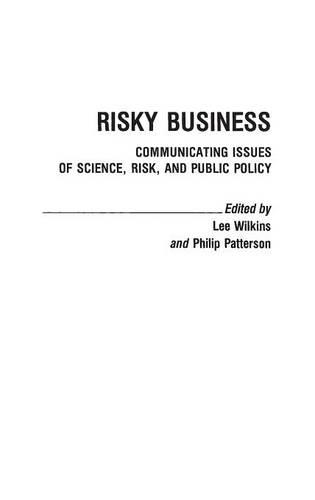
Risky Business: Communicating Issues of Science, Risk, and Public Policy
(Hardback)
Publishing Details
Risky Business: Communicating Issues of Science, Risk, and Public Policy
By (Author) Lillian C. Black Wilkins
By (author) Philip Patterson
Bloomsbury Publishing PLC
Praeger Publishers Inc
30th March 1991
United States
Classifications
Tertiary Education
Non Fiction
News media and journalism
Mathematics and Science
302.23
Physical Properties
Hardback
256
Description
The 15 chapters in this volume deal with science, medicine, technology, disaster and hazard coverage by the media from the perspectives of sociology, psychology, philosophy, and journalism. Written for the "active" reader who is concerned about the issues and willing to begin the work necessary to bring about change, the volume suggests ways in which journalists, policy makers, and citizens can work to correct some of the more pervasive problems of media coverage of science. In her foreword, Dorothy Nelkin examines the images of science and technology that are conveyed through the media and discovers the dominant theme to be that of scientists as problem-solvers, authorities, and the ultimate source of truth. Scientists are seen as pursuing an arcane activity that is both above normal human understanding and beyond criticism. Nelkin ends her overview by posing two questions that the succeeding chapters address: why is science writing so uncritical of science, and why are scientists so critical of the press The goal of the first segment of the book is the recognition that media coverage of science follows certain predictable patterns and that those patterns will not change unless journalists critically examine their work. The second half of the book looks at the decision-making process involved in judgments about what and how to publicize and what to keep secret.
Reviews
The 15 chapters deal with science, medicine, technology, disaster and hazard coverage by the media from the perspectives of sociology, psychology, philosophy, and journalism. Written for the reader who is concerned about the issues, suggests ways in which journalists, policy makers, and citizens can work to correct some of the more pervasive problems of media coverage of science.-Reference & Research Book News
"The 15 chapters deal with science, medicine, technology, disaster and hazard coverage by the media from the perspectives of sociology, psychology, philosophy, and journalism. Written for the reader who is concerned about the issues, suggests ways in which journalists, policy makers, and citizens can work to correct some of the more pervasive problems of media coverage of science."-Reference & Research Book News
Author Bio
LEE WILKINS is a Professor and Associate Dean, School of Journalism, University of Missouri, Columbia. She authored Shared Vulnerability: Media Coverage and Public Perception of the Bhopal Disaster and Wayne Morse: A Bio-Bibliography (Greenwood Press, 1987 and 1985, respectively). PHILIP PATTERSON is an Associate Professor and Chair of the Communications Department, Oklahoma Christian University. He specializes in mass-media ethics, media coverage of science, and political communication. He has been published widely in various communications journals.
